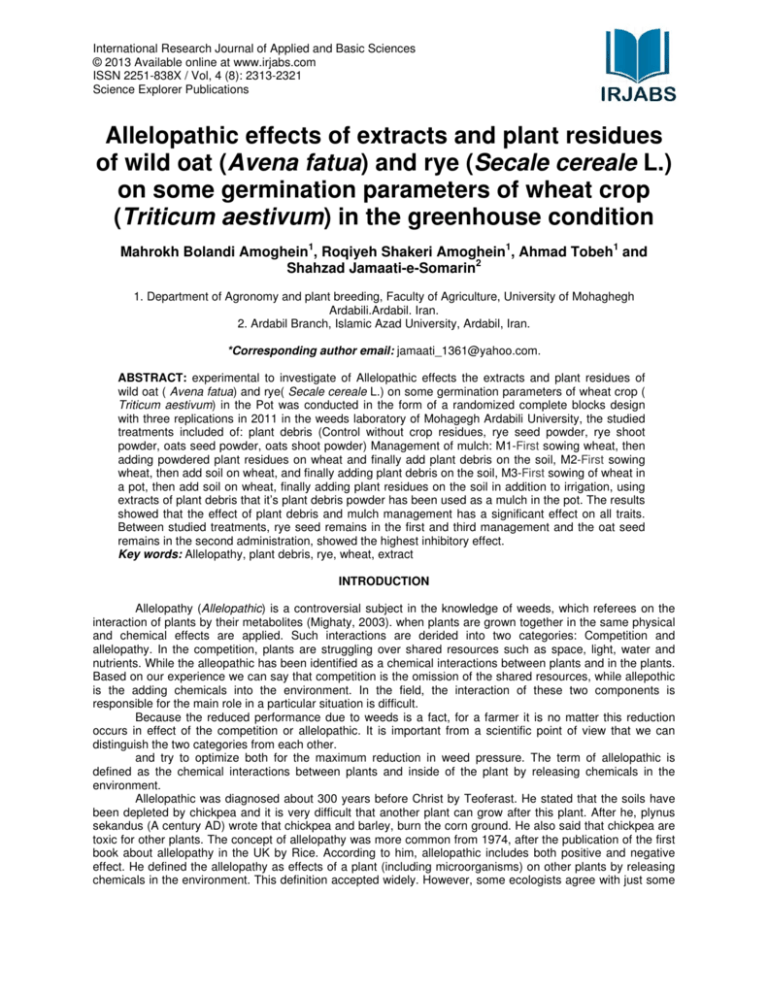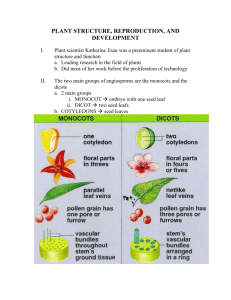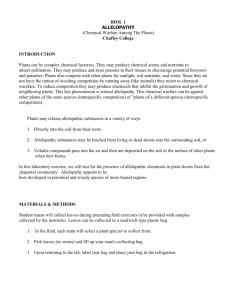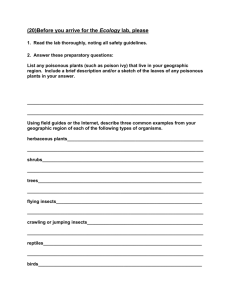Allelopathic effects of extracts and plant residues of wild oat (Avena
advertisement

International Research Journal of Applied and Basic Sciences © 2013 Available online at www.irjabs.com ISSN 2251-838X / Vol, 4 (8): 2313-2321 Science Explorer Publications Allelopathic effects of extracts and plant residues of wild oat (Avena fatua) and rye (Secale cereale L.) on some germination parameters of wheat crop (Triticum aestivum) in the greenhouse condition Mahrokh Bolandi Amoghein1, Roqiyeh Shakeri Amoghein1, Ahmad Tobeh1 and Shahzad Jamaati-e-Somarin2 1. Department of Agronomy and plant breeding, Faculty of Agriculture, University of Mohaghegh Ardabili.Ardabil. Iran. 2. Ardabil Branch, Islamic Azad University, Ardabil, Iran. *Corresponding author email: jamaati_1361@yahoo.com. ABSTRACT: experimental to investigate of Allelopathic effects the extracts and plant residues of wild oat ( Avena fatua) and rye( Secale cereale L.) on some germination parameters of wheat crop ( Triticum aestivum) in the Pot was conducted in the form of a randomized complete blocks design with three replications in 2011 in the weeds laboratory of Mohagegh Ardabili University, the studied treatments included of: plant debris (Control without crop residues, rye seed powder, rye shoot powder, oats seed powder, oats shoot powder) Management of mulch: M1-First sowing wheat, then adding powdered plant residues on wheat and finally add plant debris on the soil, M2-First sowing wheat, then add soil on wheat, and finally adding plant debris on the soil, M3-First sowing of wheat in a pot, then add soil on wheat, finally adding plant residues on the soil in addition to irrigation, using extracts of plant debris that it’s plant debris powder has been used as a mulch in the pot. The results showed that the effect of plant debris and mulch management has a significant effect on all traits. Between studied treatments, rye seed remains in the first and third management and the oat seed remains in the second administration, showed the highest inhibitory effect. Key words: Allelopathy, plant debris, rye, wheat, extract INTRODUCTION Allelopathy (Allelopathic) is a controversial subject in the knowledge of weeds, which referees on the interaction of plants by their metabolites (Mighaty, 2003). when plants are grown together in the same physical and chemical effects are applied. Such interactions are derided into two categories: Competition and allelopathy. In the competition, plants are struggling over shared resources such as space, light, water and nutrients. While the alleopathic has been identified as a chemical interactions between plants and in the plants. Based on our experience we can say that competition is the omission of the shared resources, while allepothic is the adding chemicals into the environment. In the field, the interaction of these two components is responsible for the main role in a particular situation is difficult. Because the reduced performance due to weeds is a fact, for a farmer it is no matter this reduction occurs in effect of the competition or allelopathic. It is important from a scientific point of view that we can distinguish the two categories from each other. and try to optimize both for the maximum reduction in weed pressure. The term of allelopathic is defined as the chemical interactions between plants and inside of the plant by releasing chemicals in the environment. Allelopathic was diagnosed about 300 years before Christ by Teoferast. He stated that the soils have been depleted by chickpea and it is very difficult that another plant can grow after this plant. After he, plynus sekandus (A century AD) wrote that chickpea and barley, burn the corn ground. He also said that chickpea are toxic for other plants. The concept of allelopathy was more common from 1974, after the publication of the first book about allelopathy in the UK by Rice. According to him, allelopathic includes both positive and negative effect. He defined the allelopathy as effects of a plant (including microorganisms) on other plants by releasing chemicals in the environment. This definition accepted widely. However, some ecologists agree with just some Intl. Res. J. Appl. Basic. Sci. Vol., 4 (8), 2313-2321, 2013 of the negative impacts as allelopathic. For example, Lamerz and colleagues (1998), were identified allelopathic as an inhibition of one species by another in the effect of the release of toxic compounds. Allelopathic phenomenon is important for researchers from two aspects Minimize the negative effects of allelopathy on growth and yield of crops. Utilization of allelopathy for weed management (Rashed Mohassel et al., 2006). Allelopathic chemical structure Due to the large number of secondary metabolies, for easier and better reading, it seems necessary to classify them. Classification basis of different scholars is different in this case. Phenyl propanes Astuzhyns Terpenoids Steroids Alkaloids These researches are classified the produced chemical materials by-organic Plants and microorganisms into 13 main groups as follows Water-soluble simple organic acids, linear-chain alcohols, ketones and aliphatic aldehydes. Neftokoienots, Antrokoienons, and complexed koeinons. Simple phenols, benzoic acids and their derivatives Simple unsaturated lactones Polyacetylenes and long-chain fatty acids Synamyk acids and their derivatives Amino acids and Polypeptids Flavonoids Tannins Terpenoids and Steroids Alkaloids and Syanhydryns Glucosides and Sulfides Purines and Nucleotides Allelopathic types True allelopathy The plant releases the compounds which have allelopathic properties, into the environment activity. Funication allelopathy Released compounds by plants and so microorganisms active transform into the active form of Alelo cemic. Both of the allelopathy are important. Allelopathic pattern A pattern of inhibition of other plant should be shown on a Invasive plant should produce chemicals. Invasive plant chemicals should be released in the free nature. The transferred or accumulated chemicals in the free nature should be in the concentration of biological active. Pattern observed in nature, not only by the different mechanisms of interference especially, competition for resources but also vegetarianism should be interpreted. Ways of releasing allopathic substances Gas Living plants may give off gases that are hindrance for other plants. Emissions from the plant (Salvia reflexa) contains substances such pines that has a negative effect on the germination and growth of seedling in some plants, including wheat. Species of the genus Artemisia and Eucalyptus also emit gases that they are allopathic effect. Root exudates Substances that are secreted from the roots of sorghum and poultry, prevent the growth of some plants the secreting substances form walnuts and cucumber are toxic and the substances that are exuded from plum are notoxic and in effect of activity of microorganism becomes toxic and poisoning material. The presence of Intl. Res. J. Appl. Basic. Sci. Vol., 4 (8), 2313-2321, 2013 organic materials such as Manolik Asid and Oxalic acid in the root of oxalis weed prevents its degradation by microorganism. Leaves and stems exudates Different chemical composition of the leaves and stems of plants are removed into the soil by rain water, for example, velvetleaf fytotoxin is secreted form the crack in the stems and leaves that is disported from plant by water and is removed into the soil and works on neighboring plants plant residues Plant residues may be a source of compounds with allopathic properties. Some of these compounds are glycosides containing cyanide that hydrolyzed and produce cyanide and benzaldehyde toxins. Toxins derived from green manure or plant residues that returned to the soil to improve the ground, avoid the growth of some plants (Ferguson and Rathinasabapathi, 2003; Gross, 2003). Today with the increasing world population that expected 2050 to 3/9 billion people, need to the increasing of food production is more important. However, the influx of weeds is one of the most important factors that reduce crop yield and has been reported the global damage of weeds about more than $100 billion (Singh et al., 2006). Allelopathy interference also despite that perhaps seem negligible, but by changing the result of competition for resources, may be have a widely effect (Narwal et al., 2005). In many done studies, this yield reduction with different forms is related to competition between weeds and crops and allelopathic interference between them isn't regarded. But scientific researchers after 1950 showed that allelopathic interaction between crops and weeds in yield reduction is partly responsible. Most species of weeds have inhibitory effect on crops, but some species of weeds simulate the seed germination, the growth and yield of crops. Weeds by releasing Fytuksyn from seeds, the degraded remnants, permeted and volatile materials influence the plants when sensitive plants are exposed to allelopathic compounds, germination and growth are affected by this (Bais, 2003 ; Marianne, 2000). In developing countries where weeds aren't fully controlled, part the product due to competition with or weeds allopathic effect is lost. In such conditions, recognition the kind of weeds interaction with crops will be useful in the choice of a true way for fight weeds of course the strategic allepathiy is an alternative for the weeds management in the future and by using this strategy the biological herbicides will be replaced the synthesis herbicides (Malinowski, 1990; Bais, 2003). Improve the crops yield to a large extent depends on effective management of weeds. The interactions of problematic weeds with crops has a long history and it is said that it's history is related to the beginning of agriculture. Although both crops and weeds have evolved contemporary, but over the different generation weeds has became more invasive and so more problematic by various factores related to human. At present, the cost of weed control is staggering in the worlds for example, in united states, crop yield losses due to weeds is about %12, which the costs of their control is about $35 billion (Pimentel et al., 2001). Weeds to access water compete with crops and cause a quantitative and qualitative reduction of inflammations, so that demage caused by weeds, sometimes reach 70 to 80%. So the weeds will be remembered as one of the main threats against the agricultural products (Iqbal and Wright, 1999). What with a cultivation area of 216 million hectares and an average yield of 9/2 tons per hectare is considered the most important cereal in the world (Anonymous, 2004). that in diet of many countries including Iran has a special position. To most the necessary wheat in the country and to achieve Self-sufficiency should careful to increase the productivity and maintain the maximum potential. One of the most effective ways of increasing yield potential, is the scientific management of weeds (James, 1982). Weed infestation particularly wild out weed to plains is one of the restricting factors in wheat productions wild oat is native to Europe and it is weed of more than 20 crops in 55 countries around the world and undoubtedly the most narrow leaf weeds and barley and other spring cereals over the world (Fereydon poor, 2005). Rye is one of the most important weeds in wheat fields and due to their flexibility in different environment condition, resistance to drought, high production capacity and low moisture requirement, high absorption of water and nutrient, to own the lofe cycle similar to wheat and to contain allelopatic properties, their control is difficult (poster et al., 2000). Rye today in many parts of the world in presented as a most problematic narrow leaf weeds in winter wheat fields (Poster et al., 2000 ; Stump and Westra, 2000). MATERIALS AND METHODS The experiment was conducted in form of randomized complete blocks design with 3 replication in 2011 in the weed laboratory of Ardabili Mohagegh university, the studied treatment were as follows. Plant remains at five levels: (Control without plant debris, rye seed powder, rye shoots powder, out seed powder, out shoots powder) Intl. Res. J. Appl. Basic. Sci. Vol., 4 (8), 2313-2321, 2013 Mulch management with 3 levels M1- Outset sowing wheat, then adding powdered plant residues on wheat and finally add plant debris on the soil, M2- Outset sowing wheat, then add soil on wheat, and finally adding plant debris on the soil, M3Outset sowing of wheat in a pot, then add soil on wheat, finally adding plant residues on the soil in addition to irrigation, using extracts of plant debris that it’s plant debris powder has been used as a mulch in the pot Preparation of plant extracts For preparation of the seed extract and rye and oat shoots, their various parts (seeds and shoots) after drying was crushed by the mill. For preparation of extract per every 10 grams of plant added. After soaking for 24 hours to smooth the extract this mixture is passed through the filter paper. Germination test After the wheat seed disinfected with sodium pypochlorite solution, was washed several times with distilled water, them the seeds was placed in distilled water for 3 hours to sweel (hydration), 39 pots were prepared and 15 healthy wheat seeds were planted in pots and then considered treatments were applied on seeds in every pot. Then extract and water were poured in third management for the amount that seeds needed for germination. Distilled water was used as a control for two weeks the seedlings grew under light of the fluorescent lamps and the characteristic were measured. Greenhouse experiment Greenhouse experiment was conducted in a randomized complete blocks design with three replication. A third soil, on- thirds sand, one third of the manure were mixture. After preparing the soil of pot according to considered treatments, 39 pcs pots for all the pots and to apply the mulch management in pots (1) 15 healthy wheat seeds Azar 2 Daft were prepared and sown. Then, the dried residue was weighed as much as an inch of the edge of the pot and this amount of residue considered for all the pots, again the soil thrown back to the edge of the pot. To apply the management for mulch in the pots (2), as well as 3 cm to the left edge of the pot planting was done then poured 2 cm of soil and one centimeter to the left edge, considered residues were added. To apply the management for mulch in the pots (3), the planting was done just like the pots (2). The difference is that in addition to irrigation by water, the prepared extract from the residue was poured into 15 ml per pot. The planting date is 2011/08/08 and the germination date is 2011/12/08 and until germination fixed, germination counts were done every day, irrigation and adding the extract to the pot depending on the soil of the pot. RESULTS AND DISCUSSION Number of roots Number to table (1) analysis of variance of interaction between considered treatment and management of crop mulch in 5 levels, has had a significant impact on the number of roots according to table (2), comparing the studied characteristics average and Form (1) obtained most of number of roots that control treatment (without plant debris and soil only), rye and oat shoots was used in the first and second administration. The lowest number of root, respectively, is related to the use of rye seed powder in the first and third management for crop mulch and the use of oats seed in the first and second management. We can say, among the managements, the first and third management has had the most significant effect on the number of roots (except of oats seed debris that has a greater role in reducing the number of roots in second management) alleopathic effect of centurea species on wheat, barely, alfalfa, tomatoes and lettuce have been identified and it's remains has an inhibiting effect is related to lndol derivaties and Ether soluble in water and Ether that has the most inhiniting effect on root growth (Narvel, 1999). In Arabidopsis Allelochemicals by effect on the calcium signaling cascalde and cellular PH change the expression pattern of genes and causes cell death in the meristem area and elongation of the root and eventually leads to the death of root system of susceptible plants (Bais et al, 2003). Longest root According to table (1), analysis of variance of studied characteristics, the interaction between treatments, plant mulch at 1% level has a significant effect on root length. According table (2), comparing the average of studied characteristics and figure (2), Longest root has been related to rye and oats shoots powder, especially in second management. The shortest root length is related to tome when the treatment of rye seed powder was used in first and second management and then oats seed powder like control (soil), especially in Intl. Res. J. Appl. Basic. Sci. Vol., 4 (8), 2313-2321, 2013 second management has not inhibiting effect on root length. Catechin derived from the roots of C. maculass of meristemic areas zones the elongation in root of sensitive plants and avoids their growth (Bais et al., 2003; Marianne et al., 2000). Obvious effects of allephatic compounds in germination stage included growth delat in root and stipes (khatib et al., 2004). Labbafy et al (2009), They also concluded that root length in wheat is susceptible to the rye aqueous erxtract, because it is more exposed on allelopkumikal materials Reduction in root length my indicate that cell elongation trough inhibition form Gobberellin and Indol acid affected by the allelepathic agents (Qasem, 1992). Longest hypocotyle According to table 1, analysis of variance, interaction between treatment of plant debris and the management of mulch at the 5% level has has had significant effect on wheat hypocotyle length. According (3) longest coleoptile is related to control threatment (soil whitout plant debris) and rye and oat shoots, especially in the first and second administration. Rye and oat shoots debris treatment in third management has had more inhibition effect on the coleopil length. Also, the greates impact on reducing the length of the hypocotyle is related related to the rye seed debris, especially in third management. The number of seedling According to table (1), analysis of variance, interaction between crop residue and the management of mulchs at the 5% has had a significant effect on the number of wheat seedlins. According to table (2), comparing the average of characteristics and Figure (4), the rye seed debris has had more inhibiting effect on growth and actually the reduction of the number of wheat seed seedlings, especially in first and third management after the remains of rye, oat seed remains especially in second management has had a large effect in reducing the number of seedling. Remains of rye and oat shoots in first and third management has been the same as control (soil without plant residues and actually has had no effect in reduction the number of seedlings in first and second, but in third management the rye and oat shoots with the same letters has decreased the number of seedlings. In the treatment of rye seed debris, third management and in the treatment of rye seed debris, second management have more inhibiting effect on the growth of seedling and has decreased the number of seedling. Seedling stage is a sensitive stage to allelopathic compoundings and the allelopathic we can say the amount of allelopathic compounds effectiveness in the important role in fate of the crop in following stages (Rezaei et al, 2008). allelopathic compounds are damaging to the seedlings, in this case, plant growth will be lower than the control plants (Yang et al., 2002). Shoot dry weight According to table (1) analysis of variance of studied characteristics, shoot dry weight is effected by interaction between plant debris and management of mulch and has shown a significant difference at the %1 level. According to table (2) the comparing of average and Figure (5), rye remains treatment in first and third management has a greatest impact in reducing the dry weight of shoots of wheat, however, second management just like a control with similar letters (a) has no a significant impact in reducing the dry weight of shoots of wheat. According to figure (5), we can say that all of the studied treatment, expect of rye seed in first and third management and oats seed in second management act fully similar to control treatment and placed in a same group. Hilda et al (2002), showed that the extract if Digitaria sangunalis weed had a negative effect on dried material assembling in root, shoot and seedling of Oilseed rape phenolics are able change the Mitochondrial membrance and so to prevent the energy transfer that is needed for the necessary growth process and this disorder followed by a series of physiological effect lead to a reduction in assembling of dried material in seedling (Yang et al., 2002). Factors in this process can reduce the dry weight of shoots include the reduction in absorption of nuterients from roots and leaves needed for photosynthesis and also a reduction in photosynthesis in cell division and protein synthesis and hormones, which ultimately reduces the cell growth (khatibi et al., 2004). Roots Fresh weight According to table (1), Analysis of variance of studied characteristics , fresh weight of roots is affected the interaction between plant debris and the management of mulch and has shown a significant difference at the %1 level according to figure (6) and table (1), the comparing of average m the rye seed remains treatment in first and third management and oats seed in first and second management, have taken highest inhibitory effect on fresh weight of root between the control treatment and oat shots and rye shoots observed a small difference in various management oat seed in third management and rye seed in second management hare shown a result to control. Intl. Res. J. Appl. Basic. Sci. Vol., 4 (8), 2313-2321, 2013 Emergence rate According to table (1), Analysis of variance, interaction, and management of crop residue mulch at the 1% level has a significant effect on the green rate trait. According to (7), rye seed remains in first and third management and oats seed remains in first management reduces the rate of green in wheat seed. Largest percentage of green rate is related to control treatment (soil, without residue). After control, rye and roat shoots residue showed a highest green rate in wheat. Rye shoots in second management has shown a similar result stopping at germination may be assigned to change in anzymes activity that effect on transition of storage compspunds during germination (khatib et al., 2004). Delaying or stopping the movement of stored materials can lead to a continuous shortage of ATP in seed that have been exposed on alledopathic, that ultimately leads to a reduction in germination and seedling growth (Bogatek et al., 2005). Allelopathic effect lead to not only a reduction in germination, but also causes a delay in germination that it also effects on the competition result in plants (Escudero et al., 2000). Slowing down the vital process of plants for a reduction in breathing in seeds for allelokomykals, also leads to a reduction in germination rate. Table 1. Analysis of variance of the studied characteristics affected by different levels of residue and mulch management in greenhouse conditions. control replication Plant debris Mulch management Interaction a*b error (%) cv Free degree 2 4 2 Number of roots 0.04ns 1.15** 0.08ns Longest root 0.12ns 3.18** 0.34* longest hypocotyle 1.30ns 25.06** 1.87ns Number of seedings 3.46ns 194.57** 12.60ns Dry weight of shoots 0.00017* 0.00015** 0.000010ns Means of square Fresh weight emergence of root rate 0.00015* 7.11* 0.00073** 112.09** 0.00036** 47.88** 8 28 - 0.13* 0.05 15.20 0.63** 0.12 16.22 1.62* 0.76 27.21 20.54* 6.80 25.73 0.000044** 0.000006 23.27 0.00057** 0.000059 25.20 26.69** 2.37 13.38 Significant at the five and one percentage, respectively.**and* Table2. comparision of traits affected by different levels of residue and mulch management in greenhouse conditions. Averages with similar letters are not significantly different. Levels tested control Rye seed Rye shoots Oat seed Oat shoots M1 M2 M3 Plant debris Mulch management Number of roots Longest root longest hypocotyle Number of seedings Dry weight of shoots Emergence rate 0.01a 0.004c 0.01a 0.009b 0.01a 0.01a 0.01a Fresh weight of root 0.03a 0.01b 0.03a 0.03a 0.03a 0.02b 0.03a 2.64a 0.54c 2.70a 1.62b 2.67a 2.05a 2.19a 6.10a 1.35c 5.98a 3.84b 5.81a 4.14a 5.26a 4.28a 0.69c 4.63a 2.34b 4.14a 3.44a 3.40a 13a 2.77c 13.44a 8.22b 13.22a 10.33a 10.93a 1.85a 4.44a 2.81a 9.13a .0098a 0.03ab 10.85b 14.60a 5.43c 12.93b 12.36b 12.27b 10.16b 13.54a Means with similar letter did not show significant differences. Figure1. Diagram of number of roots trait affected by interaction between different levels of residue in mulch management Intl. Res. J. Appl. Basic. Sci. Vol., 4 (8), 2313-2321, 2013 Figure2. Diagram of longest root trait affected by interaction between different levels of residue in mulch management Figure3. Diagram of longest hypocotyle trait affected by interaction between different levels of residue in mulch management CONCLUSIONS The results of this study indicate that products of shoots, rye weeds seed and oats seed debris are affected the germination and the growth. In germination and seedling growth stages, remains and extract of rye seed, in particular the first and third management, completely prevented seed germination of wheat crop. Stopping the germination may be due to a change in activities of enzme that effect on transition of reserved compouds during germination. Phelavnioeds activity on the seeds germination may be due to the transition of energy system. Regarding to the negative effects of these weeds or their residue in fields, we hope that with agricultural management in the form of stable agricultural management in the form of stable agricultural principles, in addition to a true competition, we could take steps towards the increase of growth leading of function. Identification and use of chemical compounds with allelopathic properties of these plants as biological herbicides will be an aspect of future studies. Ultimately, by more investigation other weeds in wheat field and their effects on the various numbers of wheat, we can change the management of weeds and also we can decrease the use of synthesis herbicides. Intl. Res. J. Appl. Basic. Sci. Vol., 4 (8), 2313-2321, 2013 Figure4. Diagram of the number of seedling trait affected by interaction between different levels of residue in mulch management Figure5. Diagram of dry weight of shoot trait affected by interaction between different levels of residue in mulch management Figure6. Diagram of fresh weight of roots trait affected by interaction between different levels of residue in mulch management Intl. Res. J. Appl. Basic. Sci. Vol., 4 (8), 2313-2321, 2013 Figure7. Diagram of emergence rate trait affected by interaction between different levels of residue in mulch management REFERENCE Anonymous. 2004. FAO Statistical database. Internet, www.FAO.org. Bais HP, Vepachedu ,Ramero, Gilbory, Simon, Calaway, Ragan, Vivanco,Jorge M. 2003. Allelopathy and exotic plant invasion,from molecules and genes to communities, http://abstracts.aspb.org/pb/pubiic/p44/OQ34 Bais HP, Vepachedu O, Gilroy S, Ragan M, Vivanco M. 2003. Allelopathy and exotic plant invasion, from molecules and genes to species interactions. Science, 31,1377-1380. Bogatek R, Gniazdowka A, Stepien J, Kupidlowska E. 2005. Sunflower allelochemicals mode of action in germinating mustard seeds. Alelopathy Congress, 4-7 May, Australia. 277-279. Escudero A, Albert MJ, Pita JM, Garcia FP. 2000. Inhibitory effects of Artemisia herbaalba on the germination of the gypsophyte Helianthemum squamatum. Plant Ecology. 148: 71-80. Ferguson J, Rathinasabapathi B .2003. Allelopathy: How Plants Suppress Other Plants. university of Florida. Feridonpour M, Dastfal M. 2005. Survey of competition wheat various cultivars (Triticum aestivum) with (Avena sp) weed. 24 to 26 January. Complex of essays the first Congre Iranian weeds sciences. Institute of Plant Pests and disease research. P: 218-222. Gross E. 2003. Allelopathy of Aquatic Autotrophs. First publ. in: Critical Reviews in Plant Science 22 (2003). 313-339 pp. Hasht-Beckie HJ, Heap IM, Smeda RJ, Hall LM. 2000. Screening for herbicide resistance in weeds. Weed Technol. 41:523-534. Hilda GG, Francisco ZG, Maiti RK, Sergio ML, Elia LDRD, Salomon ML. 2002. Effect of extract of Cynodon dactrylon L. and Sorghum halepans L. oncultivated plants. Crop Research. 23(2): 382-388. Iqbal J, Wright D. 1999. Effect of weedcompetition on flag leaf photosynthesisand grain yeid of spring wheat. Agric. Sci.,123: 23-30. James W, Steinsiek Lawrence R, Oliver, Fred C. Collings.1982. Allelopathic potential of wheat (triticum aestivum) straw on selected weed species. Weed sci. 30 (5): 495-497. Khatib AA, Hegazy AK, Gala HK. 2004. Does allelopathy have a role in the ecology of Chenopodium murale?. Annual Botany Fennici. 41:37-45. Labbafy MR, Maighany F, Hejazy A, Khalaj H, Baghestani AM, Allahdady I, Mehrafarin A. 2009. Study of allelopathic interaction of wheat (Triticum aestivum L.) and rye (Secale cereal L.) using Equal-Compartment-Agar method. Asian Journal of Agricultural Sci. 1(2): 25-28. Malinowski DP, Belesky DP, Feeders JM.1990. Endophyte infection may affect the competitive ability of tall rescue grown with red clover. gornal of agronomy and Crop Science. 183: 91-101. Marianne K, Morten S, Beate S, 2000. Ecological effects of allelopathic plants, a review. NERY.Technical Report No.35 http://wwwdmu.du/1 viden... Marianne K, Morten S, Beate S. 2000. Ecological effects of allelopathic plants, a review. NERY.Technical Report No.35 http://wwwdmu.du/1 viden... Mighan p. 2003. allelopathy (allelopathic) from concept to application. Partov - Vage Press. Tehran. 256 pp. Narvel SS. 1990 . Allelopathy in crop production. Scientific publishers,Jodhpur, India. Narwal SS, Palaniraj R, Sati SC. 2005. Role of allelopathy in crop production. Herbologia 6(2): 327-332. Pester TA, Westra P, Anderson RL, Lyon DL, Miller SD, Stahlman PW, Northam FE, Wicks GA. 2000. Secale cereale interference and economic thresholds in winter Triticum aestivum. WeedScience. 48: 720-727. Pimentel D, McNair S, Janecka J, Wightman J, Simmonds C, O’Connell C, Wong E, Russel L, Zern J, Aquino T, Tsomondo T. 2001. Economic and environmental threats of alien plant,animal, and microbe invasions. Agric Ecosyst Environ, 84: 1–20. Qasem JR. 1992. Pigweed (Amaranthus spp) interference in transplanted tomato (Lycopersicom esculentum). Hort. Sci. 67: 421-427. Rashed Mohassel M, Najafi H, Akbarzadeh M. 2007. Biology and control of weeds. Publications of Mashhad Ferdosy university. 404 pp. Rezaei F, Yarniya M, Mirshekari B. 2008. Allelopathic effects the extract of weeds shoots of Amaranthus, limbs, Oval paws on rape germination and growth. Agriculture Novin Knowledge Journal. 4 (100). Singh HP, Batish DR, Kohi RK. 2006. Handbook of sustainable weed management. Food Products Press. Stump WL, Westra P. 2000. The seedbank dynamic of feral rye (Secal cereale). Weed Technol. 14: 7-14. Yang CM, Lee CN, Chou CH. 2002. Effect of three allelopathic phenolics on chlorphyll accumulation of rice (oryza setiva) seedling: I. Inhibition of supply orientation. Institute of Botany, Academic Sinica, Nankang, Taipei, Taiwan.








